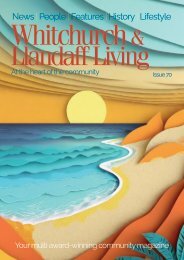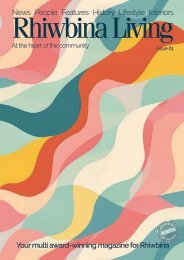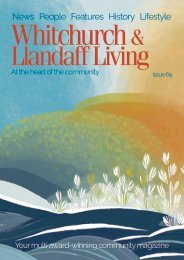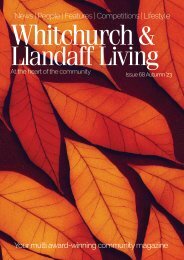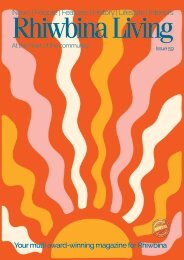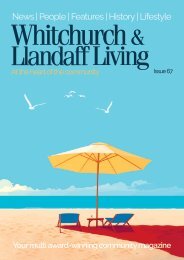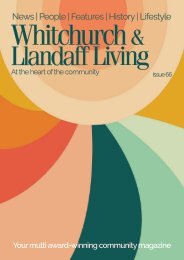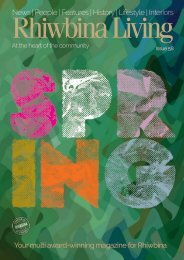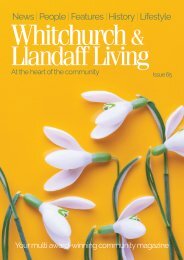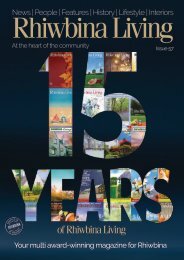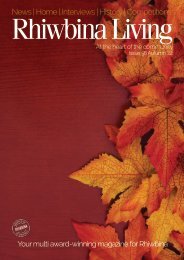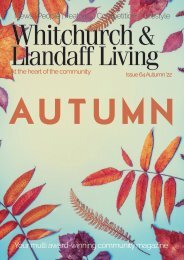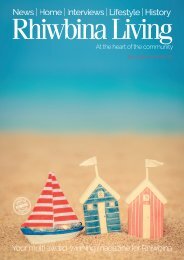Rhiwbina Living 62
Summer 2024
Summer 2024
Create successful ePaper yourself
Turn your PDF publications into a flip-book with our unique Google optimized e-Paper software.
history<br />
the old deri mill<br />
Mills around <strong>Rhiwbina</strong> were quite commonplace during the 1800s.<br />
Nigel Lewis revisits some of the more prominent ones<br />
By Nigel Lewis<br />
In the last issue of <strong>Rhiwbina</strong> <strong>Living</strong>,<br />
we looked at Beulah Corner and<br />
what a difference 180-odd years<br />
had made since the time of the<br />
parish Tithe Map.<br />
If you remember, I’d produced a<br />
map showing how rural the area<br />
was c.1875. It showed a meandering<br />
and timeless stream and the<br />
junction of a couple of rural tracks<br />
(hardly roads as we might know<br />
them). On the Tithe Map a few years<br />
earlier, the ancient ford (called<br />
Rhydwaedlyd) had been replaced<br />
by a simple humpback bridge<br />
leading north to the Deri and then<br />
by 1875, a ‘new’ shallower bridge<br />
had been constructed, with the<br />
stream diverted.<br />
There were a few scattered<br />
cottages and one or two larger<br />
houses. The first iteration of Beulah<br />
Chapel was there, and of course<br />
there were the ancient farmhouses,<br />
32<br />
but they were spread over the area.<br />
I’ve produced another map, also<br />
dated c.1875, just north-east of<br />
Beulah Corner, showing an old mill.<br />
There’s a tree-lined track off Rhydy-Walla<br />
(later renamed Beulah<br />
Road) leading to a mill. This track is<br />
now Heol-y-Felin.<br />
Just like Beulah Corner, the whole<br />
area was incredibly rural, with lots<br />
of fields. There were a few cottages<br />
and then a grander house called<br />
Ty’n-y-Coed. The parish boundary<br />
with Llanishen ran haphazardly<br />
across the area. In fact, it looks as<br />
though it ran right through Ty’ny-Coed;<br />
so apart from perhaps a<br />
living room and a bedroom, most<br />
of the house would have been in<br />
Llanishen parish! Its fields certainly<br />
were. Then there was the mill, a<br />
millpond, and a pub.<br />
The stream, Nantwaedlyd<br />
meandered as it always did, but<br />
a millrace had been constructed<br />
(quite possibly as far back as the<br />
17th century), diverting some of the<br />
stream water into the millpond. By<br />
1840 and the Tithe Map, the mill<br />
would have already been very old.<br />
At the time, it was called ‘Crofft-y-<br />
Felin’ and was owned by Mrs Rachel<br />
Lewis of Deri Farm.<br />
The fields of Deri Farm seem<br />
almost to wrap the mill, with a few<br />
more fields to the south.<br />
The mill, Crofft-y-Felin, was the<br />
largest building around (probably<br />
bigger than Ty’n-y-Coed), with the<br />
large millpond adjacent. Passing<br />
through the mill, water from the<br />
millpond was discharged via a<br />
‘tailrace’ back into Nantwaedlyd,<br />
just about where All Saints Church<br />
is today. There was also an overflow,<br />
to prevent the millpond from<br />
overtopping.<br />
So, what did the mill look like?<br />
We’ll never know for certain, but<br />
there is help from John Constable’s<br />
well-known painting ‘The Haywain’.<br />
Painted in 1821, Flatford Mill and<br />
Willie Lott’s cottage might well be<br />
contemporary with the <strong>Rhiwbina</strong><br />
Sketches: Nigel Lewis




